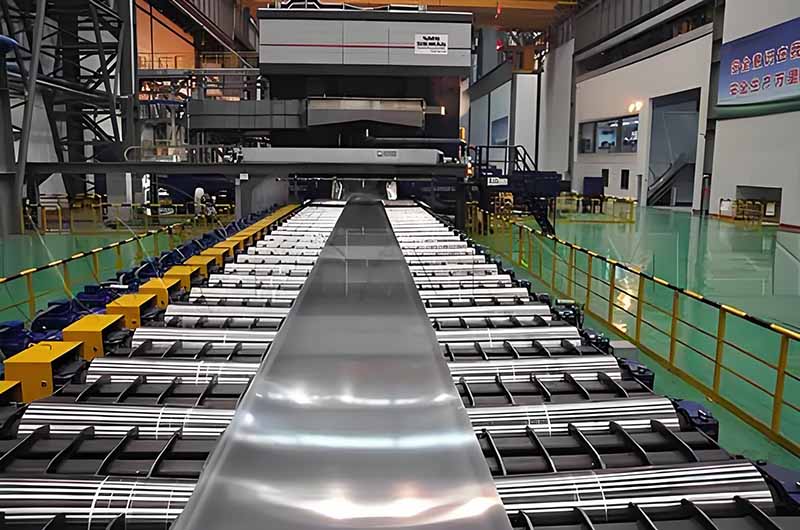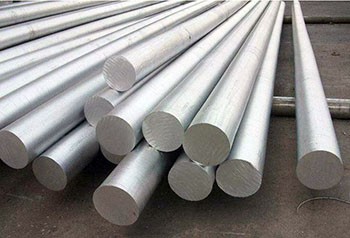5456 O Aluminum
5456-O aluminum is a corrosion-resistant aluminum alloy with magnesium as the primary alloying element, belonging to the 5xxx series of wrought aluminum alloys.
5456 O aluminum alloy is a state of the 5456 series, referring to the aluminum alloy that has been fully annealed (O state). Aluminum alloys in the O state are typically the softest, exhibiting excellent ductility and workability, but with relatively low strength. For 5456 O aluminum alloy, this state imparts some unique properties and application characteristics, making it particularly suitable for fields that require further processing.

5456-O aluminum is the annealed version of the 5456 alloy, and in the "O" (annealed) condition, the material exhibits maximum ductility and formability, making it ideal for applications that require extensive forming or bending. It is not heat-treatable; instead, its strength is developed through cold working.
5456 O aluminum prioritizes ductility and machinability over strength, making it an ideal choice for applications that require significant forming or welding before final hardening processes.
The formulation of 5456 O aluminum contains a relatively high magnesium content (approximately 4.7-5.5%), along with small amounts of manganese, chromium, and other elements such as iron, silicon, zinc, titanium, and copper. This composition ensures excellent corrosion resistance (especially important in marine environments) and helps maintain a low density of about 2.7g/cm³, contributing to reduced overall weight in structural applications.
5456 O Aluminum Characteristics
Lower Strength
Compared to other heat-treated states of 5456 aluminum alloy (such as H111, H112, H116), the strength of 5456 aluminum alloy in the O state is relatively low. Its yield strength and ultimate tensile strength are typically lower than those of the heat-treated versions, meaning it is not suitable for structural components that bear heavy loads.
Excellent Ductility
The 5456 O aluminum alloy has the best ductility among all aluminum alloy states, making it ideal for deep drawing and the production of complex shapes. This property allows it to undergo a wide range of deformation during processing, making it adaptable to more complex manufacturing requirements.
Good Weldability and Workability
Due to the loose structure of the material in the annealed state, 5456 O aluminum alloy has excellent weldability, making it easy to connect and assemble through processes like welding. Additionally, the material's workability is also excellent in the O state, making it easier to cut, bend, and machine further.
Corrosion Resistance
As a marine aluminum alloy, 5456 O aluminum alloy exhibits outstanding resistance to seawater corrosion, making it suitable for marine environments, shipbuilding, and other applications exposed to corrosive environments. Although its strength is lower in the O state, its corrosion resistance remains at a high level.
5456 O Aluminum Mechanical Properties
| Property Parameter | Value |
| Young's Modulus | 70, 000 MPa |
| Ultimate Strength | 285 MPa |
| Yield Strength | 125 MPa |
These mechanical properties indicate that 5456 O aluminum alloy is suitable for applications that require high ductility and workability, but it is not suitable for structural components subjected to high loads.
5456 o aluminum sheet and plate aluminium properties
| Unit System | tmin | tmax | Young's Modulus, E | Ultimate Strength, Fu | Yield Strength, Fy | Fwu | Fwy | Poisson's Ratio, ν | Density, ρ | Thermal Expansion Coef., α | kt |
| Metric | 6 | 80 | 70, 000 MPa | 285 MPa | 125 MPa | 285 | 125 | 0.33 | 2, 700 kg/m3 | 0.4 1/°C | 1 |
5456 O Aluminum Comparison with Other Tempers
- O state vs. H111/H116 state: The O state has lower strength but excellent ductility, whereas the H111/H116 state provides higher strength through cold working or heat treatment.
- Use case: Choose the O state for forming/welding steps; switch to hardened state for final load-bearing structures.
5456 O Aluminum Applications
Due to its excellent workability, 5456 O aluminum alloy is typically used as a semi-finished material in production processes that require further heat treatment, cold working, or deep drawing. For example, material in the O state can be cold worked, heat treated, or further processed into other states to improve strength and performance.
Shipbuilding and Marine Engineering
5456 O aluminum alloy is commonly used for pre-treatment of materials in the bottom, hull, bulkheads, and other parts of ships, especially when high corrosion resistance is required in marine environments. It performs particularly well in areas that do not bear heavy mechanical loads, resisting seawater corrosion and being easy to process and weld.
Structural Components and Corrosion-Resistant Structures
5456 O aluminum alloy is also used in the production of certain structural components, particularly when these components require subsequent processing or welding. In shipbuilding and other marine equipment, 5456 O aluminum alloy is often used as an intermediate material for preliminary welding and assembly, followed by further heat treatment or cold working to enhance its mechanical properties.
5456 O Aluminum Manufacturing and Processing
- Forming: Due to its high ductility, it performs excellently in cold forming and deep drawing. However, large amounts of cold working (reducing by >20%) should be avoided to prevent stress-corrosion cracking at high temperatures (>66°C).
- Welding: Ideal for arc welding, with good weldability in structural applications. Gas welding efficiency is lower.
- Annealing: Conducted at 343°C (650°F), followed by air cooling to restore machinability.
- Machinability: Poor; requires hard carbide tools and oil lubricants for effective processing.
5456 O aluminum alloy is fully annealed, offering the highest ductility and good weldability, making it ideal for applications requiring further processing, such as deep drawing, welding, and in industries like shipbuilding and marine engineering. Although its strength is lower, its corrosion resistance, workability, and weldability give it a significant advantage in these specific applications. In structural components requiring high strength and corrosion resistance, higher-strength heat-treated states, such as H111 or H116, are typically chosen, while the O state is more suitable for pre-treatment and complex shape processing.
Recommended for you
-
5456 marine grade aluminum plate is an economical choice for ship construction. Can be used on baseboards, decks and other upper fittings.
-
5456-H111 aluminum alloy is commonly used in the marine and shipbuilding industries, particularly in environments that require resistance to seawater corrosion.
-
5456-H112 aluminum alloy is a cold-processed and heat-treated aluminum alloy, primarily used in fields that require high corrosion resistance and moderate strength, such as the marine and shipbuilding industries.
-
5456 aluminum alloy is a high-strength aluminum alloy widely used in marine, shipbuilding, offshore engineering, and other corrosion-resistant structural components.
-
5456 H32 aluminum alloy is widely used in the marine and shipbuilding industries. It has good corrosion resistance and is suitable for anti-corrosion structural components in seawater environments.
-
5456 H321 aluminum alloy is a high-strength aluminum alloy primarily used in the marine and shipbuilding industries, especially for corrosion-resistant structures in seawater environments.
Other content readers are interested in
-
5456 5454 5754 Marine Grade Aluminum Bar
5456 5454 5754 Marine Grade Aluminum Bar has certification from CCS, DNV, NK, CCS, ABS, BV, LR, KR and other classification societies, and its quality fully complies with world marine grade standards.
-
Marine Grade Aluminum Round Bar 5754 5454 5456
The quality of 5754, 5456, and 5454 marine-grade aluminum round bars fully meets the ship classification standards worldwide: CCS, DNV, NK, ABS, BV, LR, KR.
-
5456 5454 5754 Marine Grade Aluminum Square Bars
As outstanding representatives of the Al-Mg series alloys, 5456, 5454, and 5754 marine-grade aluminum square bars each have unique performance advantages and application scenarios.
-
5454 5456 5754 Marine Grade Hexagonal Aluminum Bar
Haomei Aluminum is one of the leading 5454, 5456, 5754 aluminum hexagonal bar manufacturers in China, focusing on the research and development and production of high-quality products.
Recommended for you
-
5052 marine aluminum alloy is a high-strength, corrosion-resistant, easy-to-process and weld aluminum alloy, which is widely used in the manufacture of ships and marine structures.
-
5083 is basically used to manufacture ship hulls because of its relatively high strength and good corrosion resistance.
-
5059 aluminum is both a high-magnesium and high-zinc alloy, offering excellent corrosion resistance and fire resistance.
-
5086 aluminum alloy is irreplaceable in hull and deck applications in marine operating environments due to its unique seawater corrosion resistance, excellent low-temperature toughness, and good weldability.
-
5383 aluminum offers excellent fatigue resistance and crack resistance, and its unique properties make it irreplaceable in the design of high-speed vessels and marine structures that require long-term fatigue resistance.
-
5456 aluminum, with its unique high strength, exceptional fatigue resistance, and resistance to stress corrosion cracking, is irreplaceable in heavy-duty hull structures.
-
5754 aluminum is a medium-to-high strength alloy with excellent weldability, a low tendency for welding cracks, and high strength in both the weld joint and the crystalline metal.
More content of interest to readers
5456 Aluminum Properties 5383-O Aluminum vs. 5456-O Aluminum 5383-H32 Aluminum vs. 5456-H32 Aluminum 5383-H111 Aluminum vs. 5456-H111 Aluminum 5383 Aluminum vs. 5456 Aluminum 5383-H112 Aluminum vs. 5456-H112 Aluminum 5456-H116 Aluminum vs. 5456-H32 Aluminum 5086 Aluminum vs. 5456 Aluminum 5456-H112 Aluminum vs. 5456-H116 Aluminum 5456-H111 Aluminum vs. 5456-H116 Aluminum The application of 5456 aluminum plate in shipbuilding
You might be interested in: Marine Aluminum 5456 5 Series Marine Aluminum




